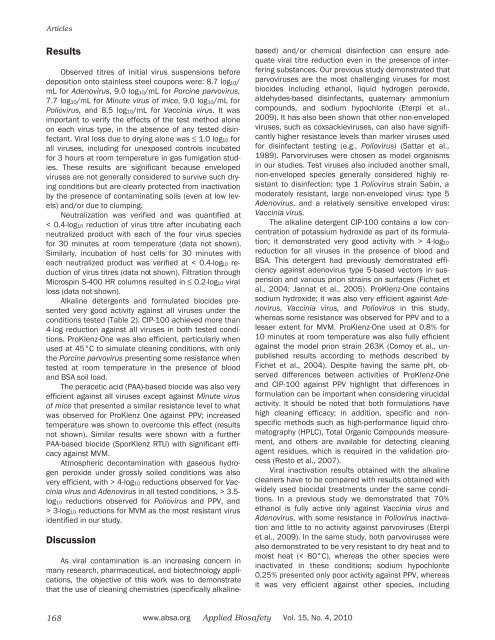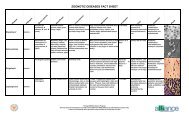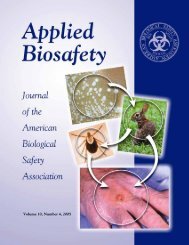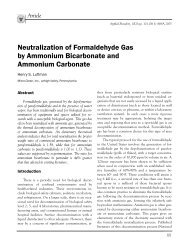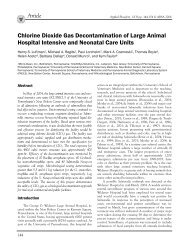Virucidal Activity of Disinfectants Against Parvoviruses - American ...
Virucidal Activity of Disinfectants Against Parvoviruses - American ...
Virucidal Activity of Disinfectants Against Parvoviruses - American ...
You also want an ePaper? Increase the reach of your titles
YUMPU automatically turns print PDFs into web optimized ePapers that Google loves.
ArticlesResultsObserved titres <strong>of</strong> initial virus suspensions beforedeposition onto stainless steel coupons were: 8.7 log10/mL for Adenovirus, 9.0 log10/mL for Porcine parvovirus,7.7 log10/mL for Minute virus <strong>of</strong> mice, 9.0 log10/mL forPoliovirus, and 8.5 log10/mL for Vaccinia virus. It wasimportant to verify the effects <strong>of</strong> the test method aloneon each virus type, in the absence <strong>of</strong> any tested disinfectant.Viral loss due to drying alone was 1.0 log10 forall viruses, including for unexposed controls incubatedfor 3 hours at room temperature in gas fumigation studies.These results are significant because envelopedviruses are not generally considered to survive such dryingconditions but are clearly protected from inactivationby the presence <strong>of</strong> contaminating soils (even at low levels)and/or due to clumping.Neutralization was verified and was quantified at< 0.4-log10 reduction <strong>of</strong> virus titre after incubating eachneutralized product with each <strong>of</strong> the four virus speciesfor 30 minutes at room temperature (data not shown).Similarly, incubation <strong>of</strong> host cells for 30 minutes witheach neutralized product was verified at < 0.4-log10 reduction<strong>of</strong> virus titres (data not shown). Filtration throughMicrospin S-400 HR columns resulted in 0.2-log10 viralloss (data not shown).Alkaline detergents and formulated biocides presentedvery good activity against all viruses under theconditions tested (Table 2). CIP-100 achieved more than4-log reduction against all viruses in both tested conditions.ProKlenz-One was also efficient, particularly whenused at 45°C to simulate cleaning conditions, with onlythe Porcine parvovirus presenting some resistance whentested at room temperature in the presence <strong>of</strong> bloodand BSA soil load.The peracetic acid (PAA)-based biocide was also veryefficient against all viruses except against Minute virus<strong>of</strong> mice that presented a similar resistance level to whatwas observed for ProKlenz One against PPV; increasedtemperature was shown to overcome this effect (resultsnot shown). Similar results were shown with a furtherPAA-based biocide (SporKlenz RTU) with significant efficacyagainst MVM.Atmospheric decontamination with gaseous hydrogenperoxide under grossly soiled conditions was alsovery efficient, with > 4-log10 reductions observed for Vacciniavirus and Adenovirus in all tested conditions, > 3.5-log10 reductions observed for Poliovirus and PPV, and> 3-log10 reductions for MVM as the most resistant virusidentified in our study.DiscussionAs viral contamination is an increasing concern inmany research, pharmaceutical, and biotechnology applications,the objective <strong>of</strong> this work was to demonstratethat the use <strong>of</strong> cleaning chemistries (specifically alkalinebased)and/or chemical disinfection can ensure adequateviral titre reduction even in the presence <strong>of</strong> interferingsubstances. Our previous study demonstrated thatparvoviruses are the most challenging viruses for mostbiocides including ethanol, liquid hydrogen peroxide,aldehydes-based disinfectants, quaternary ammoniumcompounds, and sodium hypochlorite (Eterpi et al.,2009). It has also been shown that other non-envelopedviruses, such as coxsackieviruses, can also have significantlyhigher resistance levels than marker viruses usedfor disinfectant testing (e.g., Poliovirus) (Sattar et al.,1989). Parvorviruses were chosen as model organismsin our studies. Test viruses also included another small,non-enveloped species generally considered highly resistantto disinfection: type 1 Poliovirus strain Sabin, amoderately resistant, large non-enveloped virus: type 5Adenovirus, and a relatively sensitive enveloped virus:Vaccinia virus.The alkaline detergent CIP-100 contains a low concentration<strong>of</strong> potassium hydroxide as part <strong>of</strong> its formulation;it demonstrated very good activity with > 4-log10reduction for all viruses in the presence <strong>of</strong> blood andBSA. This detergent had previously demonstrated efficiencyagainst adenovirus type 5-based vectors in suspensionand various prion strains on surfaces (Fichet etal., 2004; Jannat et al., 2005). ProKlenz-One containssodium hydroxide; it was also very efficient against Adenovirus,Vaccinia virus, and Poliovirus in this study,whereas some resistance was observed for PPV and to alesser extent for MVM. ProKlenz-One used at 0.8% for10 minutes at room temperature was also fully efficientagainst the model prion strain 263K (Comoy et al., unpublishedresults according to methods described byFichet et al., 2004). Despite having the same pH, observeddifferences between activities <strong>of</strong> ProKlenz-Oneand CIP-100 against PPV highlight that differences informulation can be important when considering virucidalactivity. It should be noted that both formulations havehigh cleaning efficacy; in addition, specific and nonspecificmethods such as high-performance liquid chromatography(HPLC), Total Organic Compounds measurement,and others are available for detecting cleaningagent residues, which is required in the validation process(Resto et al., 2007).Viral inactivation results obtained with the alkalinecleaners have to be compared with results obtained withwidely used biocidal treatments under the same conditions.In a previous study we demonstrated that 70%ethanol is fully active only against Vaccinia virus andAdenovirus, with some resistance in Poliovirus inactivationand little to no activity against parvoviruses (Eterpiet al., 2009). In the same study, both parvoviruses werealso demonstrated to be very resistant to dry heat and tomoist heat (< 80°C), whereas the other species wereinactivated in these conditions; sodium hypochlorite0.25% presented only poor activity against PPV, whereasit was very efficient against other species, including168 www.absa.org Applied Biosafety Vol. 15, No. 4, 2010


